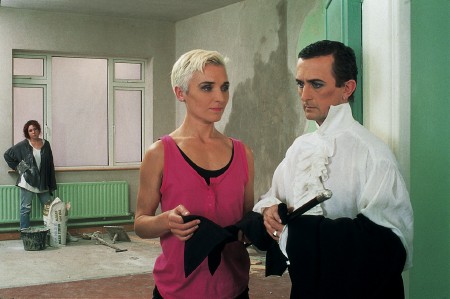James Coleman
Compton Verney, Warwickshire, UK
Compton Verney, Warwickshire, UK

‘C … O … N … Ceiling? … Concealing!’ The girl’s voice is strained, as though pressing to convey urgent meaning but struggling to decipher the letters of a text that she is reading. In the large, dark room the recording of her voice is crisp and close, and we can hear every exasperated breath, every ‘hmmm’ and ‘hah’, as she pores over the unseen script. Her perplexity over the text may well reflect the viewer’s puzzlement at a sequence of colour slides that accompany her monologue in James Coleman’s installation I N I T I A L S (1993–4). Shot in what seems to be a hospital but could almost be a theatre’s green room, the photographs depict a cast of six figures in a series of tense but ambiguous relationships that allude variously to medical procedures and to performance in front of an audience or camera. While the girl falters letter by letter and word by word through a passage that occasionally opens to reveal moments of clarity (‘Did a shadow pass? It passed, but a moment ago.’), so too does the viewer’s understanding of the projected images wax and wane over the work’s 21 minutes.
Coleman is an artist whose international standing over the past four decades (he has participated in every documenta since 1987 and is represented by three major commercial galleries) is somewhat at odds with his relative unfamiliarity to a contemporary audience in the UK. His film Retake with Evidence (2007), a grandly installed and even more grandly orated quasi-Shakespearean soliloquy delivered by Harvey Keitel, left many visitors to documenta 12 perplexed and frustrated by the lack of contextual information. Coleman is an artist who expects much of his audience; he insists on the willing participation of the viewer in attempting to unravel meaning where there are often only thickening layers of complication and uncertainty beneath the surface. It is a game that, understandably, not everyone is prepared to play.
This gruff stance can occasionally border on the antagonistic. An untitled video installation, dated 1998–2002, accompanied I N I T I A L S in an adjacent gallery. While the slides of the latter almost filled the entirety of one wall, the video was projected far smaller, reminiscent in size and position of a painting as opposed to the immersive scale of cinema. The image appeared to depict ice floes floating in deep black water, filmed from an aeroplane or satellite. The work constantly seemed to be on the point of resolving itself, for despite the stillness of the image, there seemed to be slight changes in the fading shades of grey around the white forms, as though the ice was melting or accreting before our eyes. These changes were so gradual, however, that it was only when compared with the memory of the image a few minutes previously that a difference could be detected – motion slowed down to the point of invisibility, thought replacing ocularity, and doubt elbowing its way into the viewer’s perception. ‘Did a shadow pass? It passed, but a moment ago.’
Back in the neighbouring gallery, the indistinct narrative of I N I T I A L S alternately developed and dissolved in a similar way. The opening shot of stacked hospital beds (the only image not featuring people) is double-exposed, but slowly resolves into a singular viewpoint. An androgynous male figure carefully applies make-up to the face of a man in a Byronic white shirt and waistcoat. A woman stands behind a table on which she is folding or unfolding white fabric. In the background we occasionally see what looks like medical equipment. Another woman pauses pensively, holding what looks like architectural plans. In another shot she carries a bucket and plastering tools, and we notice the freshly plastered-over cracks in the duck-egg blue walls.
While the scenes draw attention to the construction of their own artifice, there is a simultaneous sense of psychological tension that is somehow independent of the situations being enacted, a technique that draws heavily on Bertolt Brecht’s theory of the Verfremdungseffekt, the distancing or alienation effect. The actors (for this is what they clearly are) seem as internally removed from us, and from each other, as the narrator’s voice seems close. At times the girl’s voice seems to address them rather than the viewer: ‘Why do you gaze, one upon the other?’ No answer, of course, is forthcoming.
In a nearby gallery an exhibition of paintings and sculptures by Alberto Giacometti provided an unexpected complement to Coleman’s work. Giacometti’s dissolving (or rather emerging) figures, which often seem to describe the process of the artist’s apprehension of his subjects rather than their outward appearance, share Coleman’s sensitivity to the untrustworthiness of representation. Something Giacometti once said could equally be applied to the work of Coleman: ‘One continues knowing that the closer one gets to the model, the more it withdraws.’























